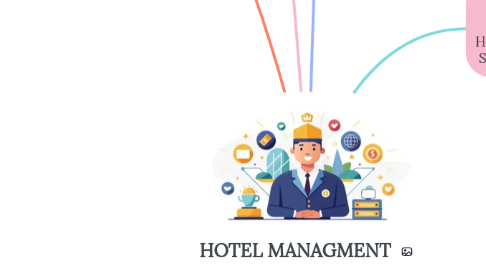
1. HUMAN RESOURCES
1.1. Funtions
1.1.1. - Recruitment and selection
1.1.1.1. Job analysis
1.1.1.2. Sourcing candidates
1.1.1.3. Interviewing process
1.1.2. - Training and development
1.1.2.1. Orientation programs
1.1.2.2. Skills training
1.1.2.3. Career development
1.1.3. - Performance management
1.1.3.1. Setting performance standarsd
1.1.3.2. Conducting evaluation
1.1.3.3. Providing feedback
1.2. Compensation and benefits
1.2.1. - Salary structures
1.2.2. - Health benefits
1.2.3. - Retirement plans
1.3. Compliance and Labor law
1.3.1. - Understanding employment laws
1.3.2. - Monitoring compliance
1.3.3. - Handling grievances and disputes
1.4. Technology
1.4.1. - Human resources Iinformation systems
1.4.2. - Payroll systems
1.4.3. - Performance tracking tools
1.5. Employee Relations
1.5.1. - Building workplace culture
1.5.2. - Managing conflict
1.5.3. - Employee engagement strateggies
1.6. Estrategy management
1.6.1. - Worforce planning
1.6.2. - Succession planning
1.6.3. - Aligning with business goals
2. OPERATION MANAGMENT
2.1. OVERSEEING MULTIPLE DEPARTMENTS AND PROVIDING GOALS
2.1.1. Evaluating, designing, and implementing business processes
2.2. OVERSEEING AND STREAMLINING PROCESSES
2.2.1. Overseeing production, distribution and quality assurance
2.3. BALANCING REVENUE AND COSTS
2.3.1. Managing and analyzing financial budgets
2.3.2. Cost reduction and efficiency improvement
2.3.3. Inventory controls and logistic
2.4. DEVELOPING STRATEGIC PLANS
2.4.1. Making strategic decisions and engaging with other senior staff members
2.4.2. Supporting HR with recruitment initiatives
2.4.3. Implementing quality control and assurance systems
2.4.3.1. Reducing errors, waste and services failures
2.4.3.2. Ensuring hygiene and safety regulations
2.5. PRODUCTION, LOGISTICS AND SUPPLY CHAIN
2.5.1. Building relatioships with stakeholders and suppliers
2.5.2. Managing logistical processes and supply chain
3. QUALITY AND SUSTANAIBLE MANAGMENT
3.1. -Environmental Responsibility. -Health and Safety Standards. -Service Excellence and Consistency. -Innovation and Continuous.
3.1.1. Conrad Hilton: Standardized luxury and service, global expansion, corporate social responsibility. Raymond Schultz: 100% Satisfaction Guarantee, cost-efficiency with quality, guest-focused service. J.W. Marriott & J.W. Marriott Jr.: Employee training, sustainability (energy and waste), corporate responsibility. Ellsworth Statler: Standardized service, introduced private bathrooms, and ensured affordable quality. César Ritz: Luxury & excellence, elite guest experience, durable & sustainable materials.
3.1.2. Quality and sustainability management in hospitality seeks to deliver exceptional service while minimizing environmental impact and generating sustainable economic benefit. Pioneers such as Statler, Ritz, Hilton and Marriott established principles that remain valid today.
4. ADMINISTRATION AND FINANCE
4.1. LEADDERSHIP AND STRATEGIC MANAGMENT
4.1.1. Implementing standard operating procedures
4.1.2. Coordinating between different departments
4.1.3. Strategic decisions making in key areas
4.2. PROVIDING RELEVANT SKILSS, INTERNAL CONTROLS AND MANAGMENT INFORMATION
4.2.1. Ensury legal regulatory compliance
4.2.2. Conducting internal and external audits
4.3. ENSURING COMPLIANCE WITH STATUTORY REQUIREMENTS
4.3.1. Managing financial risk
4.3.1.1. Implementing fraud preveention measures
4.3.1.2. Security hotel assets through insurance
4.3.1.3. Preparing for emergencies
4.4. REGURLY ANALYSING AND DISTRIBUTING FINANCIAL REPORTS
4.4.1. Allocating resources efficiently to maximize profits
4.4.2. Managing cash flow and enssuring liquidity
4.4.3. Monitoring financial performance throug key performance indicators
4.4.4. Recording daily transactions
4.4.5. Generating financial statements
4.4.6. Ensuring tax compliance
4.5. CREATING PRICES STRATEGIES
4.5.1. Implementing pricing strategies
4.5.2. Managing online and offline channels
4.6. IMPLEMENTING FINANCIAL MANAGMENT TOOLS
4.6.1. Property managment systems
4.6.2. Financial software for accounting and payroll
4.6.3. Security systems
4.7. BUDGETING A COST CONTROL
4.7.1. Preparing annual budgets for differents departments
5. MARKETING AND SALES
5.1. MARKETING RESEARCH
5.1.1. Competitor analysis
5.1.2. Customer Analysis
5.2. DiIGIITAL MARKETING
5.2.1. SEO/SEM
5.2.2. Email markting
5.2.3. Content Marketing
5.3. Reputation management
5.3.1. Online Reviews
5.3.2. Menaging Feedback
5.4. SALES
5.4.1. SALES STRATEGIES
5.4.1.1. Customer segmentation
5.4.1.2. Special package offers
5.4.2. DISTRIBUTION
5.4.2.1. Direct Channel(website)
5.4.2.2. OTAS(online Travel Agencies)
5.4.3. CUSTOMER RELATIONSHIPS
5.4.3.1. Loyalty programs
5.4.3.2. Post- sale follow-up
5.4.4. SALES CLOSING TECHNIQUES
5.4.4.1. Early Booking Discounts
5.4.4.2. Upselling and cross-selling
6. COSTUMER SERVICES
6.1. Key roles
6.1.1. Gues interaction
6.1.1.1. from check-in and check out every interaction should be welcoming and professional
6.1.2. Problem solving
6.1.2.1. Any problems must be addressed and resolved as soon as possible. This could include complaints, special requests, or preferred rooms.
6.1.3. imformation provision
6.1.3.1. Giving concise information about nearby attractions and hotel amenities and services
6.1.4. Feedback collection
6.1.4.1. attending and responding to the guests feed back to improve the services and address any shortcomings
6.1.5. Upselling and cross selling
6.1.5.1. identifying opportunities to improve the guests experiences throught additional services
7. QUALITIES OF COSTUMER SERVICES
7.1. Persuasiveness
7.1.1. influencing guests in a positive way,this qualities helps in up sellings and ensure guests feel good about their choices
7.2. Empathy
7.2.1. plays an important role in understanding guest needs,helps to created a deep interaction with the guests and their confort
7.3. Adaptability
7.3.1. the hability to adapt to different situations and create and environment more adapted to the guests needs,make a ribbon of loyalty between client and the hotel
7.4. Positivity
7.4.1. positive attitude is vital,can significantly change the perception between the guest and hotel
7.5. Effective communication
7.5.1. answering question and providing clear information is vital for guests satisfaction
8. HOTEL INDUSTRY SEGMENTATION
8.1. HOTELS
8.1.1. Luxury hotels (5-star)
8.1.2. Business hotels
8.1.3. Budget hotels
8.2. MOTELS
8.2.1. Roadside accommodations
8.2.2. Typically located along highways
8.2.3. Basic amenties, often with parking access
8.3. BOUTIQUE HOTELS AND LODGES
8.3.1. Small, unique, and stylish accomodations
8.3.2. Personalized guest experience
8.3.3. Lodges: Often in nature focused locations (mountains, safaris, etc.)
8.4. BED AND BREAKFAST
8.4.1. Small-scale, home-like accomodations
8.4.2. Personalized service with breakfast included
8.5. HOSTELS
8.5.1. Budget friendly accomodations
8.5.2. Share rooms and facilities
8.5.3. popular among backpackers and travelers
8.6. RESORTS
8.6.1. Full-service accomodations with entertainment and amenities
8.6.2. All- inclusive options available
8.6.3. Located in vacation destination
8.7. SERVICE APARMENTS
8.7.1. Fully furnished aparments with hotel-like service s
8.7.2. Ideal for long-term stays
